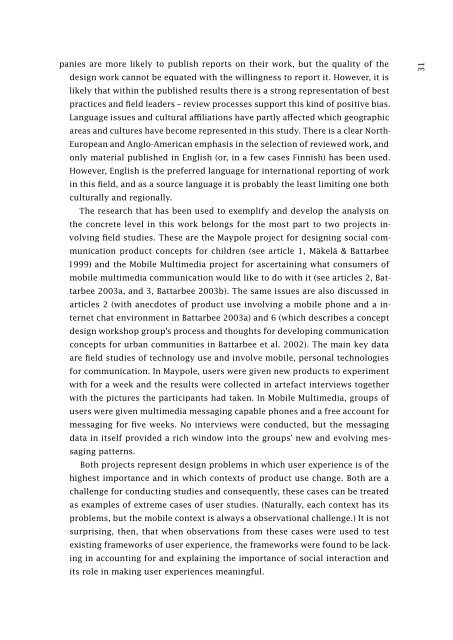Co-experience: Understanding user experiences in social interaction
Co-experience: Understanding user experiences in social interaction
Co-experience: Understanding user experiences in social interaction
Create successful ePaper yourself
Turn your PDF publications into a flip-book with our unique Google optimized e-Paper software.
panies are more likely to publish reports on their work, but the quality of the<br />
design work cannot be equated with the will<strong>in</strong>gness to report it. However, it is<br />
likely that with<strong>in</strong> the published results there is a strong representation of best<br />
practices and field leaders – review processes support this k<strong>in</strong>d of positive bias.<br />
Language issues and cultural affiliations have partly affected which geographic<br />
areas and cultures have become represented <strong>in</strong> this study. There is a clear North-<br />
European and Anglo-American emphasis <strong>in</strong> the selection of reviewed work, and<br />
only material published <strong>in</strong> English (or, <strong>in</strong> a few cases F<strong>in</strong>nish) has been used.<br />
However, English is the preferred language for <strong>in</strong>ternational report<strong>in</strong>g of work<br />
<strong>in</strong> this field, and as a source language it is probably the least limit<strong>in</strong>g one both<br />
culturally and regionally.<br />
The research that has been used to exemplify and develop the analysis on<br />
the concrete level <strong>in</strong> this work belongs for the most part to two projects <strong>in</strong>volv<strong>in</strong>g<br />
field studies. These are the Maypole project for design<strong>in</strong>g <strong>social</strong> communication<br />
product concepts for children (see article 1, Mäkelä & Battarbee<br />
1999) and the Mobile Multimedia project for ascerta<strong>in</strong><strong>in</strong>g what consumers of<br />
mobile multimedia communication would like to do with it (see articles 2, Battarbee<br />
2003a, and 3, Battarbee 2003b). The same issues are also discussed <strong>in</strong><br />
articles 2 (with anecdotes of product use <strong>in</strong>volv<strong>in</strong>g a mobile phone and a <strong>in</strong>ternet<br />
chat environment <strong>in</strong> Battarbee 2003a) and 6 (which describes a concept<br />
design workshop group’s process and thoughts for develop<strong>in</strong>g communication<br />
concepts for urban communities <strong>in</strong> Battarbee et al. 2002). The ma<strong>in</strong> key data<br />
are field studies of technology use and <strong>in</strong>volve mobile, personal technologies<br />
for communication. In Maypole, <strong>user</strong>s were given new products to experiment<br />
with for a week and the results were collected <strong>in</strong> artefact <strong>in</strong>terviews together<br />
with the pictures the participants had taken. In Mobile Multimedia, groups of<br />
<strong>user</strong>s were given multimedia messag<strong>in</strong>g capable phones and a free account for<br />
messag<strong>in</strong>g for five weeks. No <strong>in</strong>terviews were conducted, but the messag<strong>in</strong>g<br />
data <strong>in</strong> itself provided a rich w<strong>in</strong>dow <strong>in</strong>to the groups’ new and evolv<strong>in</strong>g messag<strong>in</strong>g<br />
patterns.<br />
Both projects represent design problems <strong>in</strong> which <strong>user</strong> <strong>experience</strong> is of the<br />
highest importance and <strong>in</strong> which contexts of product use change. Both are a<br />
challenge for conduct<strong>in</strong>g studies and consequently, these cases can be treated<br />
as examples of extreme cases of <strong>user</strong> studies. (Naturally, each context has its<br />
problems, but the mobile context is always a observational challenge.) It is not<br />
surpris<strong>in</strong>g, then, that when observations from these cases were used to test<br />
exist<strong>in</strong>g frameworks of <strong>user</strong> <strong>experience</strong>, the frameworks were found to be lack<strong>in</strong>g<br />
<strong>in</strong> account<strong>in</strong>g for and expla<strong>in</strong><strong>in</strong>g the importance of <strong>social</strong> <strong>in</strong>teraction and<br />
its role <strong>in</strong> mak<strong>in</strong>g <strong>user</strong> <strong>experience</strong>s mean<strong>in</strong>gful.<br />
31

















